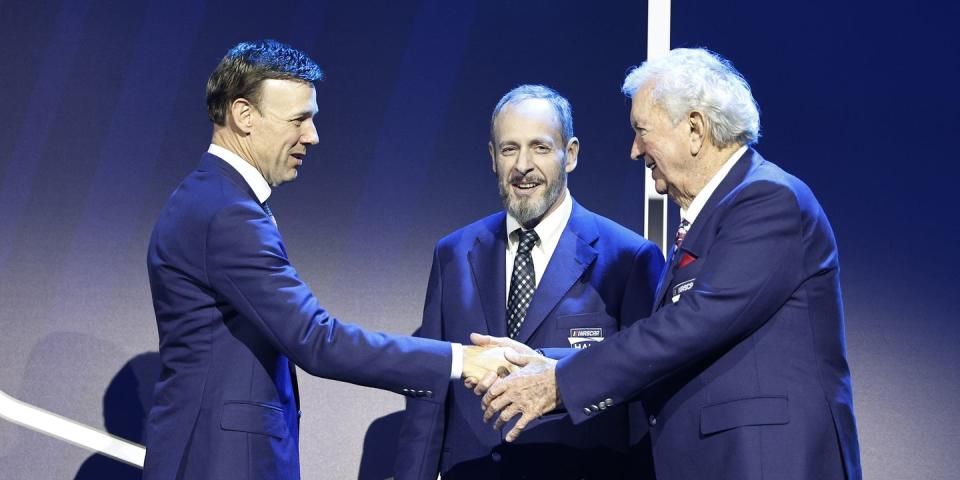
-
McGriff, 95, raced successfully for decades on the West Coast and made occasional runs in the NASCAR Cup Series.
-
Kenseth won the Cup championship in 2003, won 39 Cup races.
-
Shelmerdine was a standout along Cup pit rows in the 1980s and ’90s, guiding the Richard Childress Racing crew and driver Dale Earnhardt.
Membership in the NASCAR Hall of Fame reached 61 Friday night with the induction of Matt Kenseth, Kirk Shelmerdine and Hershel McGriff in a ceremony at the Charlotte Convention Center.
McGriff, 95, raced successfully for decades on the West Coast and made occasional runs in the NASCAR Cup Series. He raced for the final time in 2018 at the age of 90 and joked—apparently—Friday that he would hit the track again at 100.
McGriff had the good fortune to meet NASCAR founder Bill France Jr. in 1950 when both raced in the first Pan-American race, a five-day marathon across Mexico. France invited McGriff to venture south to run in NASCAR, and the Oregon driver made a mark immediately by winning four races in 1954. He had several opportunities to become a regular in the Cup but decided to stay in Oregon to raise his family and tend to his business interests there.
After his induction, McGriff recounted much of his long life, including the fact that he drove a hearse, an ambulance, a milk truck and dump trucks before race cars.
“My speech shouldn’t be too long because most of the people I want to thank are dead,” McGriff joked.
He said team owners Richard Childress and Bill McAnally had offered to build a race car for him when he turned 100. “I hope they both stay healthy,” McGriff said.
Kenseth won the Cup championship in 2003, won 39 Cup races and was the near-perfect example of a smart, opportunistic driver who knew the ins and outs of point racing. In his 2003 title season, he won only one race but finished in the top 10 25 times.
Kenseth, whose Cup career ran from 1998 to 2020, won the Daytona 500 twice.
He burst onto the Cup scene in September 1998, substituting at Dover Speedway for Bill Elliott, who missed the race to attend his father’s funeral. Kenseth finished sixth, cementing ideas along the pit road that he could be a future star.
Shelmerdine was a standout along Cup pit rows in the 1980s and ’90s, guiding the Richard Childress Racing crew as driver Dale Earnhardt to win championships in 1986, ’87, ’90 and ’91.
He began his career in NASCAR as crew chief for driver James Hylton’s independent team, later moving to DiGard Racing for a short period before joining RCR. He won 46 races for the Chevrolet team—44 with Earnhardt and two with Ricky Rudd.
Shelmerdine called Hylton “one of a kind, a championship-winning mechanic who turned driver and took me from a raw Yankee kid to a decent mechanic in three years.”
Shelmerdine praised Childress as “a good friend and great leader and like a big brother to me. He gave me a leeway to build the car I thought we needed, right or wrong—maybe a little of both.”
With most of his RCR crew sitting at a table nearby, Shelmerdine described them as a “gang of exceptional misfits.” Of Earnhardt, who would win seven championships on the way to becoming a member of the Hall of Fame’s first class, Shelmerdine said, “Sometimes even we thought he was magic.”
Shelmerdine said the race cars from his period were “stock cars … with big horsepower. Just Detroit iron. Much massaged, yeah, some more than others but a very long way from whatever that is they’re racing now.”
Also honored Friday night were NASCAR vice chairman Mike Helton, who received the Landmark Award for contributions to NASCAR, and the late photographer T. Taylor Warren, who received the Squier-Hall Award for news media excellence.

